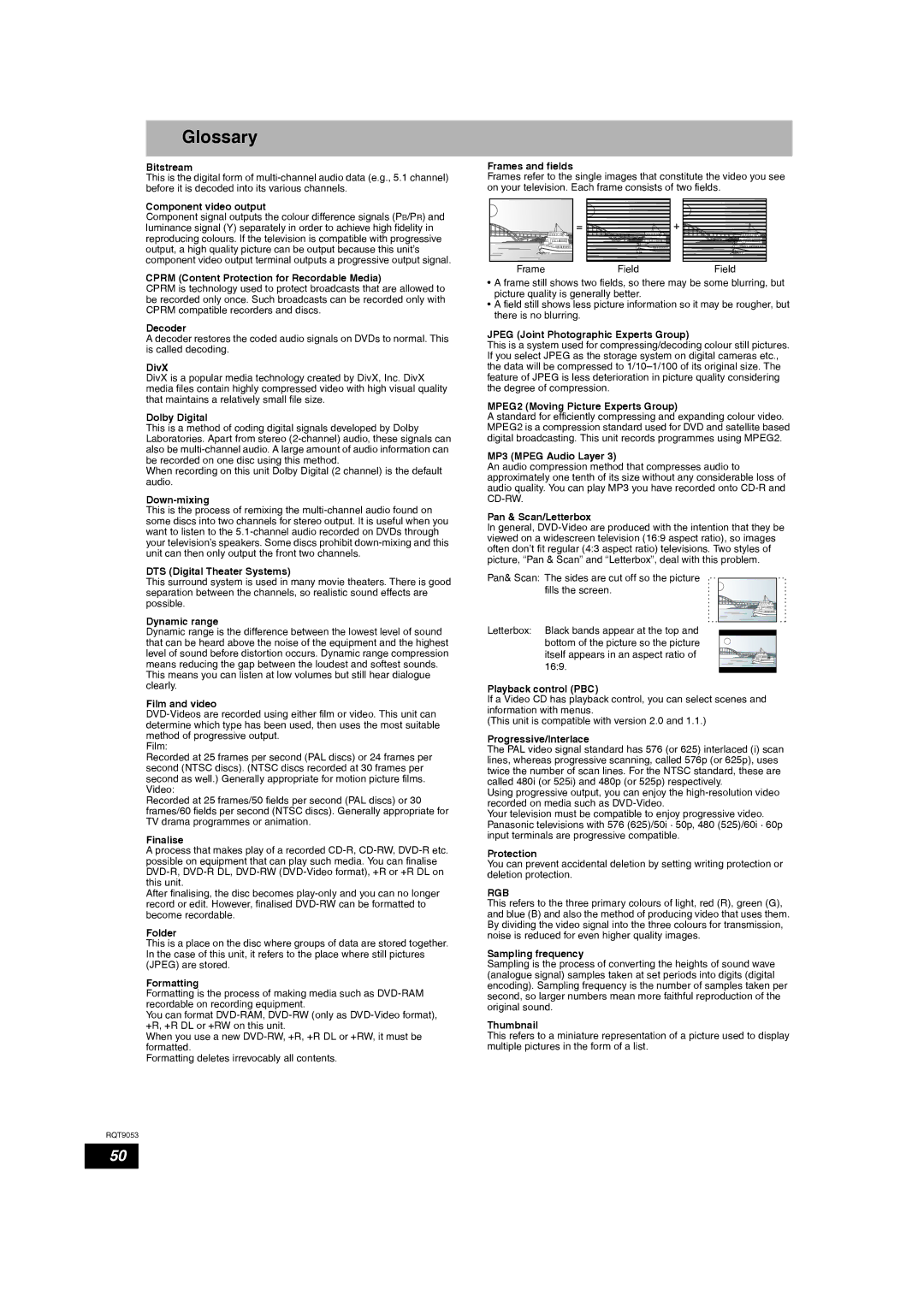
Glossary
Bitstream
This is the digital form of
Component video output
Component signal outputs the colour difference signals (PB/PR) and luminance signal (Y) separately in order to achieve high fidelity in reproducing colours. If the television is compatible with progressive output, a high quality picture can be output because this unit’s component video output terminal outputs a progressive output signal.
CPRM (Content Protection for Recordable Media)
CPRM is technology used to protect broadcasts that are allowed to be recorded only once. Such broadcasts can be recorded only with CPRM compatible recorders and discs.
Decoder
A decoder restores the coded audio signals on DVDs to normal. This is called decoding.
DivX
DivX is a popular media technology created by DivX, Inc. DivX media files contain highly compressed video with high visual quality that maintains a relatively small file size.
Dolby Digital
This is a method of coding digital signals developed by Dolby Laboratories. Apart from stereo
When recording on this unit Dolby Digital (2 channel) is the default audio.
Down-mixing
This is the process of remixing the
DTS (Digital Theater Systems)
This surround system is used in many movie theaters. There is good separation between the channels, so realistic sound effects are possible.
Dynamic range
Dynamic range is the difference between the lowest level of sound that can be heard above the noise of the equipment and the highest level of sound before distortion occurs. Dynamic range compression means reducing the gap between the loudest and softest sounds. This means you can listen at low volumes but still hear dialogue clearly.
Film and video
Film:
Recorded at 25 frames per second (PAL discs) or 24 frames per second (NTSC discs). (NTSC discs recorded at 30 frames per second as well.) Generally appropriate for motion picture films. Video:
Recorded at 25 frames/50 fields per second (PAL discs) or 30 frames/60 fields per second (NTSC discs). Generally appropriate for TV drama programmes or animation.
Finalise
Aprocess that makes play of a recorded
After finalising, the disc becomes
Folder
This is a place on the disc where groups of data are stored together. In the case of this unit, it refers to the place where still pictures (JPEG) are stored.
Formatting
Formatting is the process of making media such as
You can format
When you use a new
Formatting deletes irrevocably all contents.
Frames and fields
Frames refer to the single images that constitute the video you see on your television. Each frame consists of two fields.
| = | + |
Frame | Field | Field |
•A frame still shows two fields, so there may be some blurring, but picture quality is generally better.
•A field still shows less picture information so it may be rougher, but there is no blurring.
JPEG (Joint Photographic Experts Group)
This is a system used for compressing/decoding colour still pictures. If you select JPEG as the storage system on digital cameras etc., the data will be compressed to
MPEG2 (Moving Picture Experts Group)
A standard for efficiently compressing and expanding colour video. MPEG2 is a compression standard used for DVD and satellite based digital broadcasting. This unit records programmes using MPEG2.
MP3 (MPEG Audio Layer 3)
An audio compression method that compresses audio to approximately one tenth of its size without any considerable loss of audio quality. You can play MP3 you have recorded onto
Pan & Scan/Letterbox
In general,
Pan& Scan: The sides are cut off so the picture fills the screen.
Letterbox: Black bands appear at the top and bottom of the picture so the picture itself appears in an aspect ratio of 16:9.
Playback control (PBC)
If a Video CD has playback control, you can select scenes and information with menus.
(This unit is compatible with version 2.0 and 1.1.)
Progressive/Interlace
The PAL video signal standard has 576 (or 625) interlaced (i) scan lines, whereas progressive scanning, called 576p (or 625p), uses twice the number of scan lines. For the NTSC standard, these are called 480i (or 525i) and 480p (or 525p) respectively.
Using progressive output, you can enjoy the
Your television must be compatible to enjoy progressive video. Panasonic televisions with 576 (625)/50i · 50p, 480 (525)/60i · 60p input terminals are progressive compatible.
Protection
You can prevent accidental deletion by setting writing protection or deletion protection.
RGB
This refers to the three primary colours of light, red (R), green (G), and blue (B) and also the method of producing video that uses them. By dividing the video signal into the three colours for transmission, noise is reduced for even higher quality images.
Sampling frequency
Sampling is the process of converting the heights of sound wave (analogue signal) samples taken at set periods into digits (digital encoding). Sampling frequency is the number of samples taken per second, so larger numbers mean more faithful reproduction of the original sound.
Thumbnail
This refers to a miniature representation of a picture used to display multiple pictures in the form of a list.
RQT9053
50
